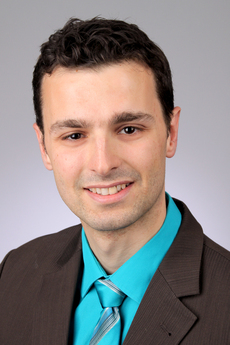| Title | Image | Source | Short Description |
|---|---|---|---|
| Effiziente und dynamische Drehmomenteinprägung in hoch ausgenutzten Synchronmaschinen mit eingebetteten Magneten | |||
| Mitigation of Current Harmonics in Inverter-Fed Permanent Magnet Synchronous Machines with Nonlinear Magnetics | PCIM Europe 2015, International Conference and Exhibition for Power Electronics, Intelligent Motion, Renewable Energy and Energy Management |
Inverter nonlinearities and machine spatial harmonics yield unwanted machine current harmonics, causing control loop instabilities, additional losses and torque ripples. In this paper a method is presented that allows online identification and compensation of both effects for anisotropic permanent magnet synchronous machines with nonlinear magnetics. The method requires no additional sensors and only fundamental component machine model parameters. It can be implemented easily in existing inverter systems by software updates. Test bench measurements show significant improvements in the whole operational area. Measurements at nominal operation result in a motor current total harmonic distortion of 0.28 % which is less than a seventh of the uncompensated value. The functional principle is transferable to other machine types or grid applications enabling the mitigation of current harmonics in a wide field of applications. |
|
| Transient Trajectory Control of Permanent Magnet Synchronous Machines with Nonlinear Magnetics | IEEE International Conference on Industrial Technology (ICIT), 2015 |
High performance interior permanent magnet syn-chronous machines show nonlinear magnetics due to saturation and cross-coupling. Nonlinear differential equations describe these phenomena and make feedback control challenging. This paper presents a predictive control method to precisely control the dynamics of these machines. Four real-time capable strategies to online identify transient trajectories are proposed: Two straight line trajectories, a strategy that yields a fast torque response and a strategy that reaches the reference values in a short amount of time. A predictive control method to force the machine to precisely follow the selected trajectory is developed and analyzed using simulations and test bench measurements. Thus, advantages and disadvantages of specific trajectories are identified. This allows the selection of a proper strategy depending on the drive requirements. |
|
| Control and dynamic performance of the Quasi-Z-Source-Inverter feeding an Interior-Permanent-Magnet-Synchronous-Machine | International Symposium on Power Electronics, Electrical Drives, Automation and Motion (SPEEDAM), 2014 |
||
| Predictive Current Control of Saturated Cross-Coupled Permanent Magnet Synchronous Machines | 2014 International Symposium on Power Electronics, Electrical Drives, Automation and Motion (SPEEDAM), Ischia, Italy, |
Highly utilized permanent magnet synchronous machines show magnetic saturation and cross-coupling effects. These phenomena are described by nonlinear differential equations and make feedback current control of the machine challenging. State of the art current control methods usually ignore these effects and hence do not produce optimal results in transient operation or in operation at the inverter voltage limit. Therefore, this paper presents a method to design a current controller taking into account saturation and dynamic cross-coupling. Feed forward calculation of transient quantities in realtime enables complete decoupling and dead-beat behavior which is experimentally validated by test bench measurements. With this approach, strongly nonlinear, highly utilized synchronous machines can be successfully controlled achieving best control quality in all operational conditions. |
|
| Dynamic overmodulation for highly dynamic current control of IPMSM with saturation characteristics | International Symposium on Power Electronics, Electrical Drives, Automation and Motion (SPEEDAM), 2014 |
This paper describes and investigates different dynamic overmodulation strategies applied to highly dynamic current control of interior permanent magnet synchronous machines. Although the machine is highly utilized, which indicates significant saturation characteristics, a linearized PI-Controller with excellent dynamic performance is used. The impact of voltage limitation with use of overmodulation on the current control quality is investigated and described. |
|
| High Dynamic Rotor Oriented Current Control for Permanent Magnet Synchronous Machines with Saturation Characteristics | PCIM Europe 2014, Nuremberg, Germany |
||
| Analysis of Current Harmonics in Inverter-Driven Interior Permanent Magnet Synchronous Machines | EPE'13 ECCE Europe, Lille, France |
This paper presents the analysis of current harmonics in an inverter-driven interior permanent magnet machine for different modulation methods. In contrast to other approaches, the influence of the saliency (Ld <> Lq) on the harmonics is being considered. By use of the rms-value of the currents, analytically closed equations can be deduced and tedious Fourier analyses of single harmonics can be avoided. The derivation of the analytic equations is described and the results are verified by numerical simulation as well as by experimental results. |
|
| Simple Strategy of Overmodulation in Control of Interior Permanent Magnet Synchronous Machines for Improving Efficiency in Automotive Applications | PCIM Europe 2013, Nuremberg, Germany |
In automotive applications, efficiency of the drive train is very important due to the limited energy in the battery. Improvement can be achieved by increasing the inverter output voltage through overmodulation. This can be used for either increasing output power or reducing power losses. |

